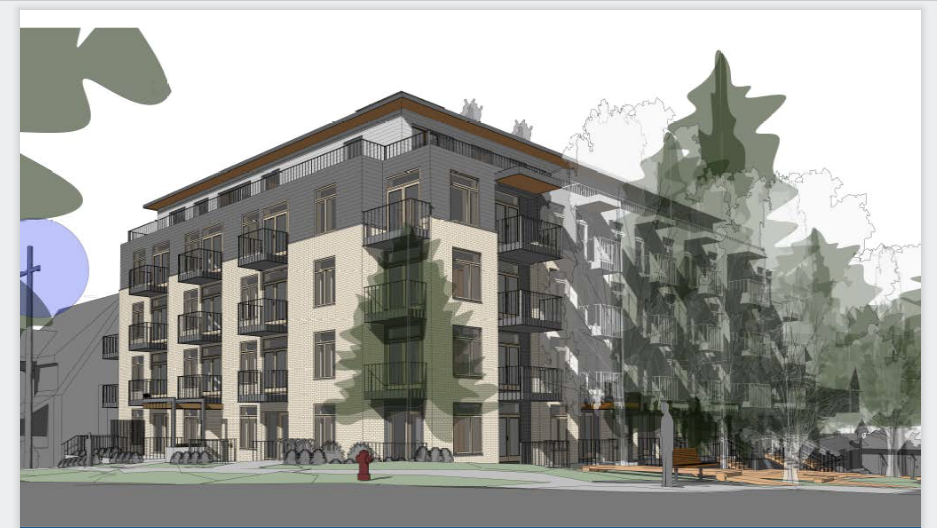Coun. Colleen Hardwick, who voted in December 2019 against the 63-unit project at Larch Street and West Second Avenue, questioned the changes Tuesday as council was set to ratify the building’s form of development in an administrative motion.
“I do believe that the integrity of our process is compromised when we see this kind of variation going from when we passed something at public hearing to when we get it in the form of an administrative motion,” Hardwick told council.
Project drops three-bedroom rental units
Of the 63 homes , 13 were to be set aside for tenants or households who earn between $30,000 and $80,000, as dictated under the city’s Moderate Income Rental Housing Pilot Program, or MIRPP.
The rezoning application from Jameson Development promised 20 two-bedroom apartments and six three-bedrooms, often referred to as family-sized. Kitsilano had a vacancy rate of zero for three-bedrooms at the time of application.
The final form of development approved Tuesday — with Hardwick opposed and councillors Rebecca Bligh and Jean Swanson abstaining from the vote — increased the number of homes to 68, with 14 now dedicated to moderate income households.
The number of two-bedrooms increased by two from the original application, but three-bedrooms dropped from six to two. Of the 14 moderate income units, three will be two-bedrooms and two will be three-bedrooms.
No three-bedrooms will be built for rent at the market level; the original application promised five.
“We were sold on family-friendly, we were sold on larger units, we were sold on neighbourhood context,” Hardwick said. “I don’t want to see projects coming in and getting council sold up on the warm and fuzzy aspects…and when we get the final version coming for ratification through this administrative motion, that it’s a different thing altogether.”
Bligh questioned the city’s deputy director of planning, Theresa O’Donnell, on how she would explain to the public the reduction of three-bedrooms, which was one of the major considerations for the project when promoted last year.
'Always a balancing act'
“We struggled with that quite a bit ourselves, and it’s always a balancing act,” O’Donnell replied. “When these projects come to the council, they’re often in conceptual form. What we try to emphasize is that when we’re talking with the public and with the council, that these plans [are] not quite gelled yet.”
The project, however, still meets the 35 per cent threshold for the number of two and three-bedroom units, as outlined in a city policy. If the original number of family-sized homes would have gone ahead, the threshold would have been at 41 per cent.
“This was the unit mix that we believe the applicant landed on that was a financially viable project that also met all of the form of development requirements,” O’Donnell said of the final unit mix of the 68 homes.
The increase in number of homes was in coordination with design upgrades, including an overall reduction in height by three feet and the rear setback increased from three feet to 10 feet.
Added brickwork, new type of siding along with changes to windows, porches and entrances were also incorporated into the design, which O’Donnell described as having more of a “neighbourhood feel.”
Coun. Adriane Carr voted against the initial proposal but supported the administrative motion Tuesday to move the project ahead.
Last year's public hearing attracted divided residents to speak out
“This vote is about the form of development and whether the applicant has actually worked to make modifications to the form that respond to the conditions of approval, which are also generated by the concerns raised by the public, and I believe that’s happened,” Carr said.
Debate over an administrative motion is rare at council, with such motions typically adopted on consent. But city staff anticipated there might be questions related to changes in the project and quickly prepared a short PowerPoint presentation for council.
The questions prompted Coun. Michael Wiebe to request more detailed information be added to administrative motions so the public can learn how their input was incorporated into the final design of a project.
“We’ve been working with the clerk to try to make sure that all of these reports and this information is available to the public,” O’Donnell said.
“But these slides were pulled together specifically for this afternoon. As you know, we don’t typically get questions on form of development. It’s usually kind of a consent item type of thing, so the public wouldn’t have had access to these [slides] because quite frankly they were only finished up just about an hour ago.”
The public hearing last year attracted dozens of residents, divided by supporters calling for more housing and detractors arguing the building was too dense and would be a bad fit for Kitsilano.
@Howellings




